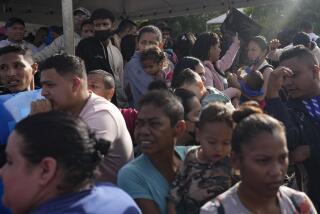Brazil Finds Itself an Agricultural Superpower : South America: Crop production has grown 47% since 1980, thanks to scientific advancements.
- Share via
FORMOSA, Brazil — Out here on Brazil’s high plains, a verdant carpet of soybean sprouts stretches to the horizon. Wheat, tangerines, cucumbers, avocados, even strawberries, are flourishing on the fertile cerrado .
The Green Revolution has arrived, bringing its combination of better seeds and high-tech agriculture to one of the last farming frontiers--a savanna 10 times the size of Kansas.
Thanks to the cerrado, Brazil is expected to produce a record harvest for a third consecutive year, riding a farming boom that experts say will boost it far above its present rank as the world’s No. 5 food exporter.
Farmers in Formosa, 1,000 miles from the nearest port in the state of Goias, are lobbying with others in the cerrado for a rail line or canal to get their crops to the coast for export.
“In the 1940s, this was only a dream,” said agronomist Norman Borlaug, whose research on wheat spurred the Green Revolution in Asia and won him the Nobel Peace Prize in 1970.
Now that Asia is reaching the upper limit of how much food its crowded lands can produce, Borlaug expects it to buy a lot of Brazilian soybeans, rice, beans, grapes, apples, wheat and other crops.
“Today, Brazil has learned to cultivate its land. It’s increasing productivity, and it still has so much unused land to explore,” he said.
Brazil’s farm production has grown 47% since 1980, faster than any other industry. Over the same period, industrial production grew 11%.
Even though the amount of land being farmed hasn’t changed since 1980 and subsidies to farmers have been cut in half, Brazil harvested a record 75.2 million tons of grains and oil seeds last year.
On the 500-million-acre cerrado, where farmers still are tilling only a fifth of the arable land, grain production has quadrupled in the last 25 years to 20 million tons a year.
The leap in productivity is the result of new farm equipment, irrigation and progress in soil microbiology and biological pest control.
“We can avoid opening up new farm areas, conserve our natural resources, and still significantly raise production,” said Darci Gomes of the Cerrado Research Center near Brasilia, the capital, 50 miles south of Formosa. “We’re only scratching the surface of what we can do here.”
For years, farmers ignored the cerrado, a wasteland of crooked trees and scrub, because it was too far from the big cities of the Atlantic seaboard and its soil was too acid.
That changed in 1960, when the government carved the futuristic new capital, Brasilia, out of the cerrado’s red-clay plain to draw Brazilians to the heartland.
Scientists at the Cerrado Research Center found that adding limestone and phosphate--minerals found in abundance in the cerrado--to the soil made it fertile.
Then they developed virus-free seeds, and discovered a wasp and a viral disease that would control two longtime pests--the caterpillar and beetle.
In 1970, only 9,900 tons of soybeans were produced on about 8.9 million acres in the central-western states of Goias, Mato Grosso, Mato Grosso do Sul and Minas Gerais.
By 1985, farmers in those states needed only 7.4 million acres to grow 6 million tons of soybeans. Last year, they doubled output to 11.8 million tons--about half of Brazil’s soybean harvest.
Today, the cerrado produces 45% of Brazil’s coffee, a third of its soybeans, rice and corn, and a tenth of its wheat and beans.
The stunning growth of the cerrado’s prosperity is reflected in Formosa, a backwater town that grew into a small city with street lights, running water, a high school, hospital and movie theater.
Vitor Euripes Stabile and his wife sold their home in the southern state of Parana in 1984 and moved to Goias state to manage a seed farm on 6,175 acres.
The farm soon grew to 10,000 acres and began producing soybeans, corn, beans and fruits and vegetables. The Stabiles bought new tractors, plows and combines with profits from rising soybean harvests.
“Things were tough at first, but I call this ‘God’s country’ now,” said Stabile, 37, stepping gingerly through rows of wheat sprouts that ran to the horizon.
Despite the cerrado’s potential, obstacles remain.
Land is cheap and rainfall is steady, but the region is far from the big southeastern markets of Rio de Janeiro, Sao Paulo and Belo Horizonte. With no rail or river links, farmers must pay high trucking costs.
“All the highways are lousy, but when a trucker goes on a real bad one he charges more,” said Jonas Lopes Neves, an agronomist at the Cerrado Research Center. “By the time our soy reaches port, it’s tripled in price.”
Farmers are lobbying for a railroad to link the heartland to the port of Santos, Latin America’s largest, 900 miles southeast.
Another idea is a $1.3-billion, 2,130-mile-long waterway that would join the Parana and Paraguay rivers and run to the cerrado from Uruguay’s port of Nueva Palmira.
“People here are working hard, producing a lot of food,” Stabile said. “We need a way to send it to market. Otherwise, how are we going to stay out here?”
More to Read
Sign up for Essential California
The most important California stories and recommendations in your inbox every morning.
You may occasionally receive promotional content from the Los Angeles Times.













